Guavas (Psidium guajava) are oval-shaped tropical fruits native to Central America and Mexico. According to statistics, it is the fourth most important fruit in the world after mangoes, bananas, and citrus fruits. Later, Guava is harvested across Asia and predominantly on the Indian subcontinent.
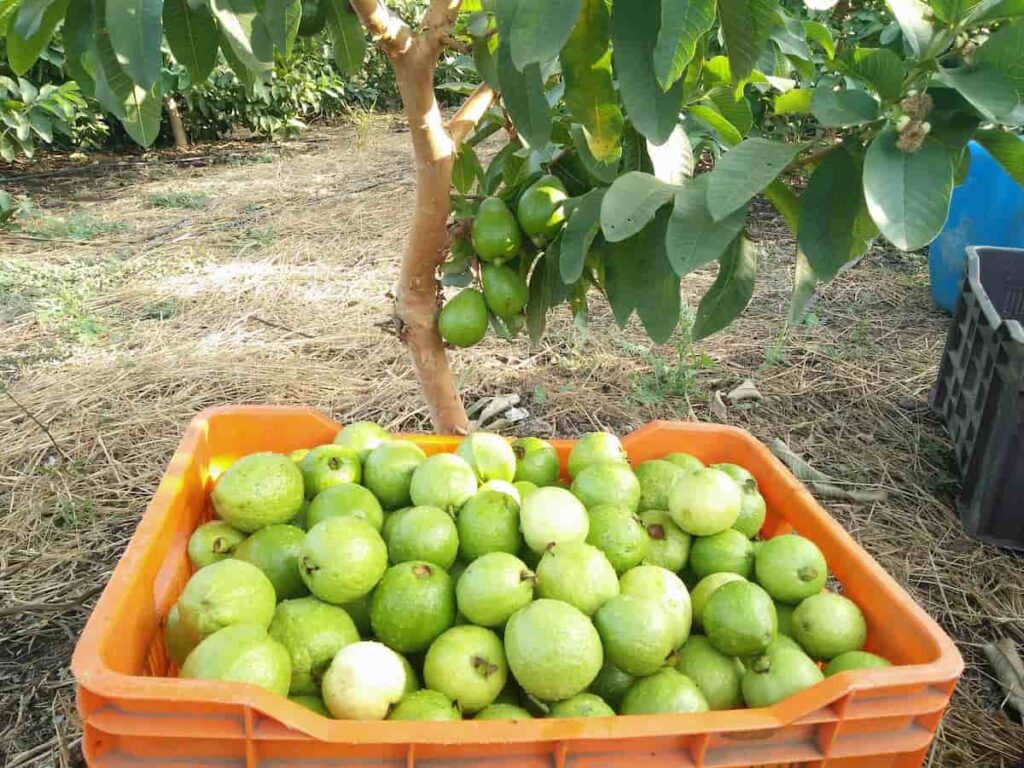
There are approximately 30 different varieties of guavas available in India. The most widely cultivated varieties of Guava are white and pink, but there are wide other varieties. Before becoming a fruit, the Guava is a tiny 5-petal white flower with several stamens at the end of each petal. A Guava looks like a greenish-yellow fruit on the outside, with white or pink flesh within, and the flesh is packed with seeds inside.
Interestingly, guavas are native to tropical America, but India has established itself as the world’s leading supplier of guavas. Some of the most prominent states in India that grow Guava are Bihar, Uttar Pradesh, Maharashtra, Andhra Pradesh, Tamil Nadu, West Bengal, and Orissa, apart from Punjab and Haryana. In addition, several countries import Guava from India, including the USA, United Arab Emirates, Netherlands, Saudi Arabia, Jordan, and Kuwait.
High yield hybrid Guava varieties in India
Climatic conditions and suitable soil types for the cultivation of Guava
The cultivation of guavas is possible in both subtropical and tropical climates. A maximum height of 5000 feet (1500 meters) is the maximum height it can reach above sea level. The best time of year to bloom guavas is between June and September when rainfall is less than 1000 mm per year. There is a greater need to take care of young plants due to their vulnerability to cold and dry environments.
Guava plants are hardy that thrive in various soil conditions, including heavy clay soils. Some soils, such as heavy, well-drained soils, are ideal for this plant. It is, nevertheless, susceptible to waterlogging. Because Guavas are surface-rooted trees, the best soil for growing them is well-drained, deep friable soil with rich topsoil. As far as the soil’s surface is concerned, it should be fertile. The pH level of the soil ranges between 4.5 and 8.2. Alkaline and saline soils are not suitable for the cultivation of guavas.
Guava varieties cultivated in India
It is believed that Guava has been cultivated for many centuries in various regions of the world, but the total number of trees per acre has not exceeded 100. As a result, the yield was limited, and the quality was mediocre. Therefore, a few varieties have emerged in India over the past few years, and some have been imported from foreign countries. Due to this change, the fruit size increased, the quality of the fruit improved, and the yield greatly improved.
In case you missed it: High Yield Hybrid Banana Varieties in India: State Wise Guide
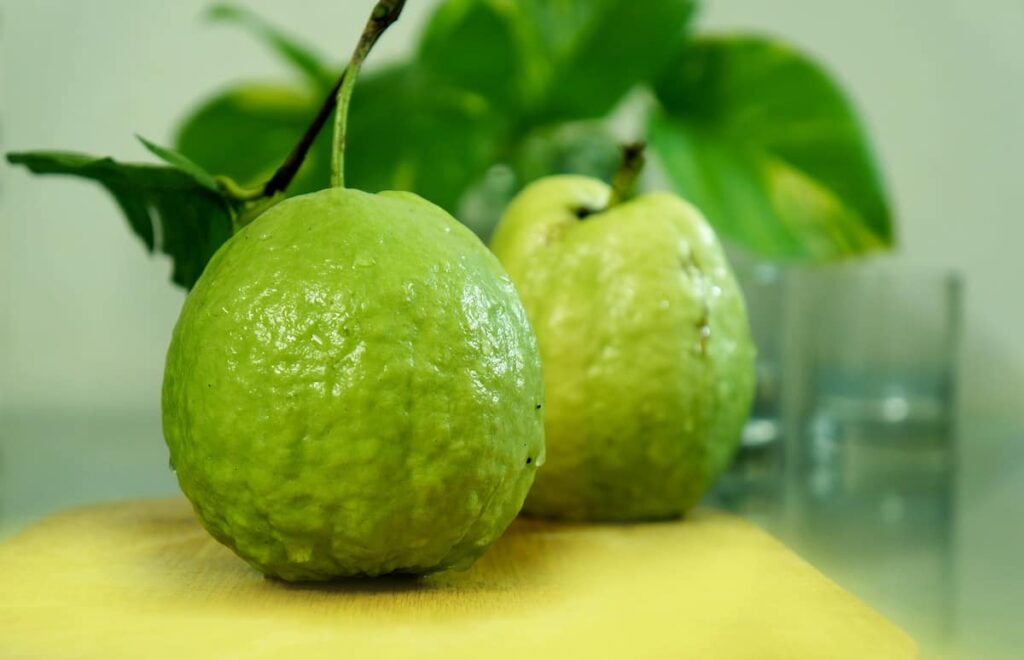
Arka Amulya
It is a progeny from the cross Allahabad Safeda x Triploid. It is a medium-vigor plant with a spreading type of growth. The fruits of this plant are round in shape. It has smooth skin and is yellow. On average, the fruit weighs about 180 to 200 grams, and the flesh is white and firm. As far as the TSS is concerned, it is around 12 Brix, soft-seeded, and the weight of 100 seeds is approximately 1.80 grams. Keeping quality is good. The average yield of this variety is 10 tons per acre and 144 kilograms per tree.
Safed Jam
The plant is a hybrid from the Hyderabad region of Karnataka between ‘Allahabad Safeda’ and ‘Kohir’ (a local collection unique to that region). Its growth habits and fruit quality are similar to the ‘Allahabad Safeda’ variety. There are few soft seeds in the fruit; the fruit is bigger and of good quality.
Arka Kiran
It is a hybrid Variety that has been created by combining Kamsari x Purple Local. Approximately 200 grams is the average weight of the fruits with a slight pear shape. The fruit’s pulp is pink and high in Lycopene, and the seeds are soft and have a TSS of about 12° Brix. Two years after the crop was planted, the crop will be ready for harvesting. As a result of the spacing of four meters x three-meter, the average harvest begins after five years, with an average yield of 20 tons per acre.
Arka Mridula
It is a selection from a seedling that has been open-pollinated from the Allahabad Safeda plant. Despite their semi-vigorous nature, the plants are spreading. The fruits are round in shape and weigh about 180 grams on average. It has a yellow color and is smooth in texture. It’s a white-fleshed fruit, and its TSS is around 12° Brix. As for the seeds, they are soft-seeded; the weight of 100 seeds is about 1.60 grams. Keeping quality is good. It is estimated that the pectin content is 1.041%. For making jelly, this is a good product to use.
Arka Rashmi
The plant is a hybrid from the cross between Kamsari and Purple Local. In terms of size, the fruits are round and weigh about 200 grams each. In terms of the pulp, it is a deep pink color with a high content of ascorbic acid and Lycopene. As far as the seed texture is concerned, it is medium soft with a TSS of 11°Brix. Economic yield starts after five years with an average fruit yield of 16 tons per acre at a spacing of 4 meters x 3 meters.
In case you missed it: High Yield Hybrid Mango Varieties in India: State Wise Growing Guide
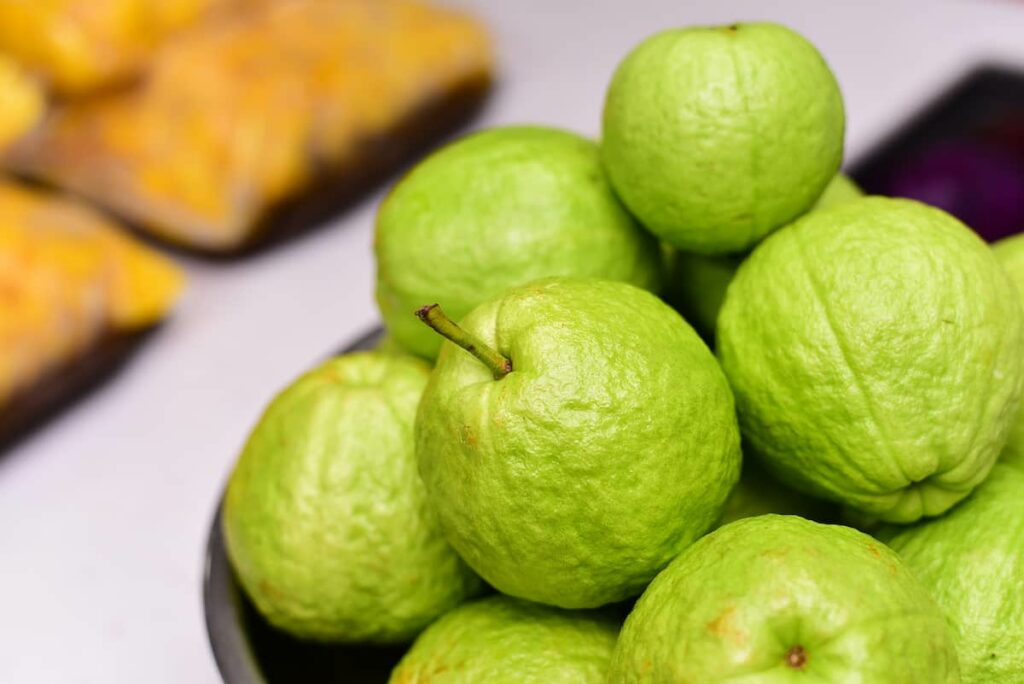
Hisar Safeda
Developed at CSS HAU, Hisar, it is a cross between Allahabad Safeda and seedless. A compact crown and upright growth habits characterize the plants. The fruit is round with smooth surfaces and creamy white pulp with a few soft seeds with a high TSS (12 to 13° Brix).
L-49 /Lucknow-49
This dwarf variety is also known as Sardar and has spreading branches. The fruit is greenish-yellow with a rough surface and a milky-white sweet pulp. Despite its relatively thick skin, the core contains the smallest soft seeds. In Maharashtra and Tamil Nadu, they are highly sought after because of their sweetness and low seed content. There is a potential yield of 10 tons per acre. In terms of TSS, it ranges between 10 and 12%. It produces an average yield of 130 to 155 kilograms per tree. The pulp contains 130 mg of vitamin C per 100 grams.
Hisar Surkha
It is a cross between Apple color and Banarasi Surkha. The crown of the tree is broad to compact. Fruits have yellow skin with a few red spots and a pink pulp with a good TSS (12 to 13° Brix).
Lalit
It comes from a high-yielding variety. Primary and high-density plantings are suitable for this variety. The fruit is round, weighs 150 grams, and has pink pulp suitable for eating and processing.
Red flesh
The fruits are medium-sized, with red pulp, almost round, and smooth-skinned. There are plenty of seeds, but they are soft. Per 100 grams, fruits deliver 386 mg of vitamin C. They are sweet and have a high vitamin C content.
Shweta
Central Institute for Subtropical Horticulture, Lucknow, released it for business development. With a medium stature and a productive carrier, this tree is semi-incredible. Medium-sized spherical fruits have velvety white skin, red spots, and nearly white flesh. The benefits of fruits are numerous, and they are highly nutritious.
Allahabad Safeda
In ripening, the fruit develops a sweet taste and pleasing flavor and has a few seeds. It has a large size, a round shape, smooth skin, white pulp, soft, firm, light yellow color, and soft, firm texture. In India, it is the most popular and progenitor of wide varieties.
Allahabad Surkha
The red pulp type was released at the Allahabad Agricultural Institute, Allahabad. The fruits have uniform pink skin with a deep pink pulp and are sweet and strongly flavored.
In case you missed it: High-yield Hybrid Papaya Varieties in India: How to Grow, Fertilizers, Pests, and Diseases
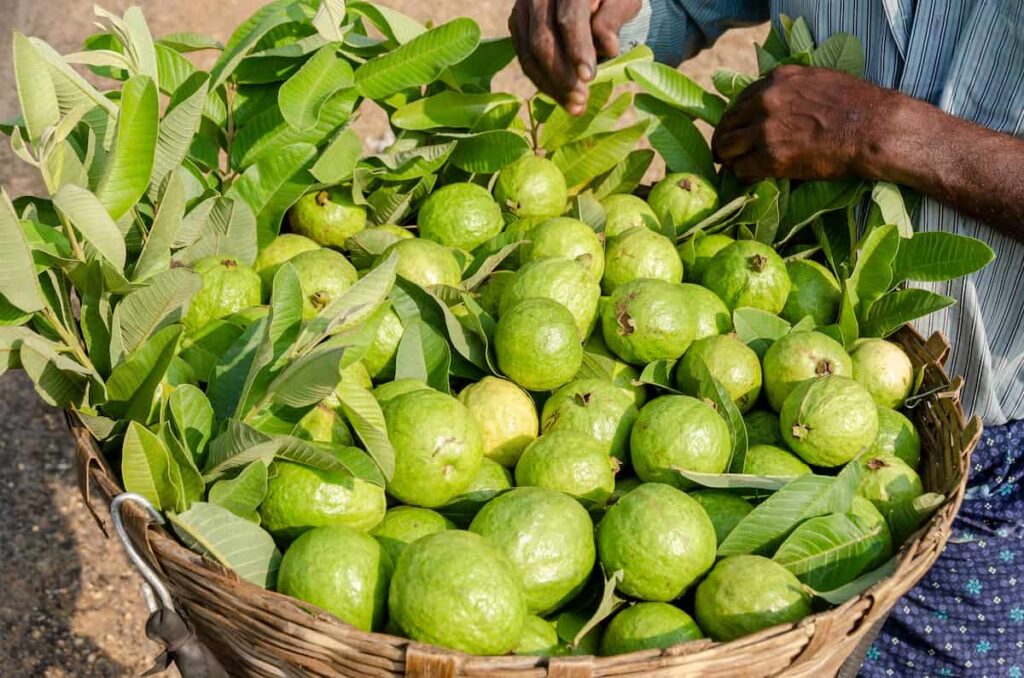
Pant Prabhat
G B Pant University of Agriculture, located at Pantnagar, developed and released this hybrid variety. In addition to growing upright, this tree produces a high amount of fruit (100 to 125 kg). Its medium size, smooth skin, white pulp, and medium soft seeds make it a good choice for picking.
Banarasi
This variety reaches a height of 4.0 to 5.5 m, with a broad crown of rounded, light-yellow fruits. In most cases, it is cultivated for consumption purposes.
Harijha
It is a species that can attain a height of approximately 3.5 m to 4.5 m and has a sparse branching pattern. Despite their round shape, they are greenish-yellow in color and have a sweet taste.
Growing seasons of Guava in India
The Guava plant begins bearing fruit two to three years after planting but reaches full maturity between eight and ten years after planting. In addition to cropping patterns and age, cultural practices determine a plant’s yield. An estimated 10-year-old plant produces 10 to 100 kilograms of guavas each year.
The Guava growing season in north India is from August to December, with Andhra Pradesh cultivating guavas throughout the year. Rainy-season crops are planted from August to September, winter crops are planted from November to December, and spring crops are planted from March to April.
In case you missed it: High Yield Hybrid Grapes Varieties in India: State Wise Varieties Cultivated
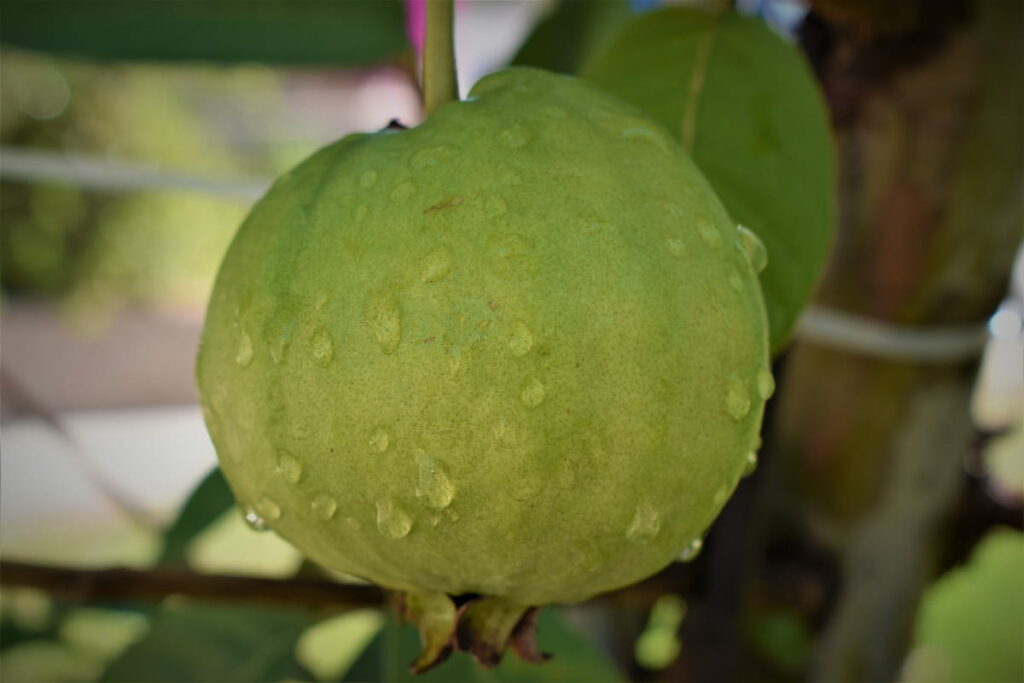
Tamilnadu’s peak guava season is between April and May and October to November. Therefore, the yield of crops during the winter season may be higher than during the rainy season. In addition, different states in India have different seasons for guava fruit. For example, in Andhra Pradesh, the guava season lasts all year, whereas, in Arunachal Pradesh, it only lasts from July to October.
State-wise list of guava varieties in India
| State | Variety |
| Andhrapradesh | Lucknow-49, Anakapalli, Banarasi, Chittidar, Hafshi, Safed jam, Allahabad-safeda, Sardar, Smooth green, and Arka mridula |
| Karnataka | Arka mridula, Arka amulya, Bangalore, and Dharwar, followed by Assam Am Sophri, Madhuri Am, Allahabad-safeda, L-49, and Safrior payere, are famous |
| Tamilnadu | Banarasi, Bangalore, Chittidar, Hafshi, Nagpur seedless, Anakapalli, smooth green |
| Madhyapradesh | Allahabad-safeda, Hafshi, seedless chittidar |
| Jharkhand | Allahabad-safeda and L-49only |
| Bihar and Jharkhand | Chittidar, Hafshi, Sardar, selection -8, Allahabad-safeda, apple color |
| Gujarath and Maharashtra | Dholka, Kothrud, L-24, L-49, Nagpur seedless, Dharwar, Nasik, and Sindh |
| Uttarpradesh | Allahabad surkha, Sardar, Mirzapuri seedless, red fleshed, Allahabad-safeda, apple color, Chittidar, Lucknow safeda, CISH G-1 |
| West Bengal | Dudhe khaja, gole kajha, kalbi, L-49, Allahabad-safeda, chittidar, harijha baruipur. |
| North-Eastern states | Allahabad-safeda and red fleshed |
Tips to increase yield in Guava farming
- It is best to cultivate Guava on deep clay soil with well-drained topsoil. Alkaline or saline soils are not suitable for growing Guavas. Manure and compost can be added to the soil to amend it, and river sand can be added to help drain it.
- Choosing a variety that gives a high yield will depend on the climatic conditions in your area.
- Most guavas are grown under rainfed conditions, and irrigation is generally not practiced. However, irrigation should still be given to guava trees in summer, October, or November since it increases fruit set and yield.
- Winter watering reduces fruit drop and increases fruit size. There are many benefits to drip irrigation for guava crops. Water is saved by up to 60%, and fruits are significantly larger and more abundant. Create saucer, half-moon, or V-shaped basins to retain moisture after pre-monsoon showers.
- During the rainy season, guava fruits are not of high quality and have a short shelf life. Therefore, spray 10 percent urea from April to May when most flowers have opened. The result is heavy and high-quality winter guava since rainy-season crops are eliminated.
- Pruning one leaf pair of guava plants in May avoids rainy season crops effectively, resulting in higher yields and better quality for winter crops.
- It is beneficial for guava cultivation to use organic manure and inorganic fertilizers. Every year, feed your plants 100 grams of nitrogen, 40 grams of potassium, and 40 grams of phosphorus. During the sixth year, you will most likely be able to maintain stability in feeding fertilizers to plants. Divide them equally in August and January.
- Your guava crop will yield more fruit if you spray it with 0.4 percent Boric Acid or 0.3 percent ZnSO4 before flowering.
- A fruit’s quality and yield can be improved by training. Training is designed to build a tree with robust branches capable of bearing high-yield crops, thus creating a productive foundation.
- As mulching material, dry leaves or straw can be used. In addition, black polyethylene sheets or organic materials can be used for the process. Maintaining moisture in the soil and improving fruit quality can be achieved by mulching it at least twice a year.
- Branches less than 30 cm from the ground are chopped off. It is important to leave the center clear. It is well recommended to allow the plant to grow four scaffold branches. Maintain a wide enough angle between the stem and the branches to allow sufficient sunshine to reach the center.
- For good crop growth and yield, weed control is essential. Apply Gramoxone 6ml per liter of water in March, July, and September to control weed growth. When weed growth is active (before weeds flower and reach a height of 15-20 cm), apply Glyphosate at 1.6 liters per acre post-emergence. One acre of land can be sprayed with 200 liters of water.
In case you missed it: How to Grow Watermelon Faster: Best Tips to increase Flowering, Fruiting, and Production Yield
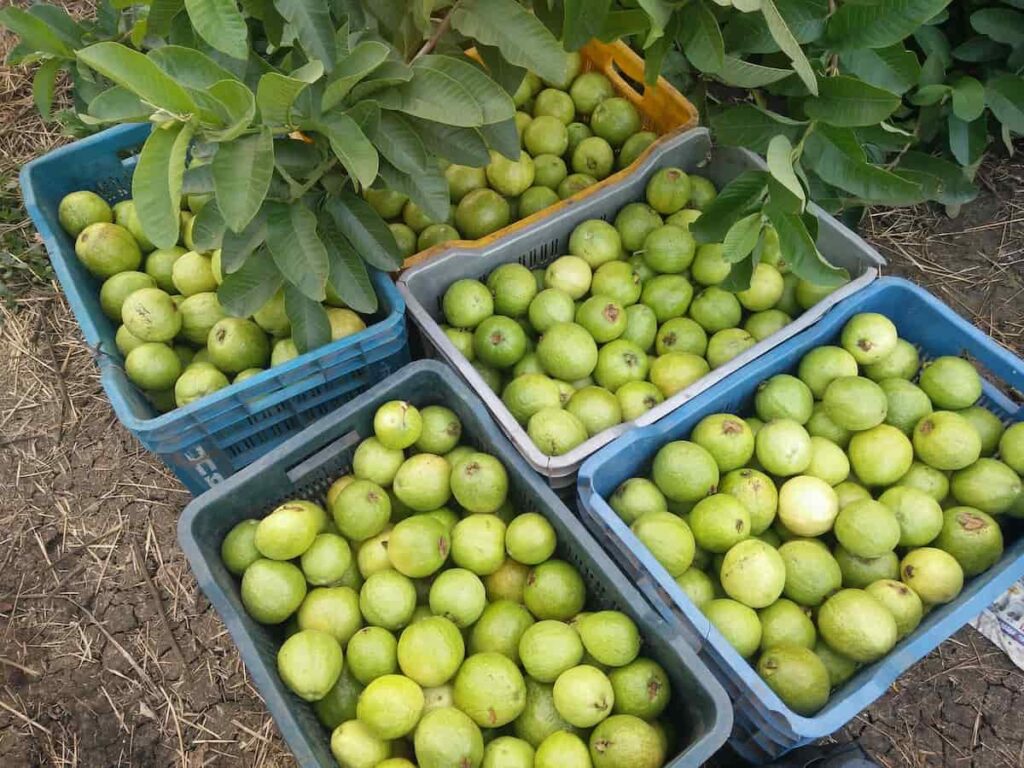
Guava crop harvesting
After planting, vegetatively grown plants begin bearing after three years and continue to yield economically for 30 years. Fruits become greenish-yellow when they reach maturity. Therefore, it is important to harvest at the right time and avoid over-ripening fruits since it deteriorates quality and test. A 100 to 150 kg annual yield can be expected from well-grown and well-cared-for trees. A grafted tree can produce up to 350 kg of fruit per year, whereas a seedling plant can produce up to 90 kg.
Three-year-old Lucknow 49 trees produce between 55 and 60 kilograms under ideal conditions. A variety’s yield depends on the type of cultivation, the location, and how the orchard is managed. Throughout the country, guavas are harvested throughout the year (except in May and June). It is, however, advisable to harvest crops during the rainy season in August, the winter season in November to December, and the spring season in March to April in north India. Climates in other parts of the country are mild, so peak harvest periods are less clear.
Fully yellow but firm fruits are harvested for local markets, while half-yellow fruits are picked for distant markets. Selection is made by hand, along with the stalk and leaves of the fruits. The fruits should be marketed within two days of harvesting since they are highly perishable. Long-distance marketing is not suitable for overripe fruits. The self-life of fruits has been reported to be increased by hormones such as Mh and GA. When kept at 8°C to 10°C and 80 to 90% relative humidity, the fruits can be stored for four weeks in cold storage.
Conclusion
Growing a hybrid and high-value crop can yield better returns for farmers. For Guavas to meet the increased demand throughout the year, hybrid Guava varieties are developed. In addition to accommodating changes in food consumption, particular Guava variety demands can also be met by cultivating hybrids.
- Profitable Village Farming Business Ideas in 2024
- High-Yield Aquaculture: Fast-Growing Fish for Farming
- Effective Fish Pond Construction Techniques for Beginners
- Irrigation and Water Management in Pineapple Farming
- Blossom to Harvest: Mastering Flowering and Pollination in Papaya Farming
- Pig Fattening Essentials: From Selection to Sale for Beginners
- Raising Wagyu Cattle: A Complete Guide for Premium Beef Production
- Soil Types and Their Water Holding Capacity
- Optimizing Irrigation Schedules for Coconut Groves for Enhanced Yield
- Espresso Your Garden: Coffee Grounds for Healthier Acid-Loving Plants
- The Best Soil Mix for Snake Plants: How to Mix Your Own Snake Plant Soil
- Green Thumb Success: Expert Tips for Cultivating Greenhouse Beans All Year Round
- Bloom All Year Round: The Ultimate Guide to Indoor Hyacinth Care
- Eco-Friendly Gardening: How to Make Liquid Fertilizer from Kitchen Waste
- Ultimate Guide to Grow Anise in Pots: Explore Seed Propagation to Harvesting
- Guide to Raising Chester White Pigs: Discover Breed Facts to Growth Management
- Mastering the Elegance: The Ultimate Guide to Weeping Cherry Tree Care, Planting, and Maintenance
- Ultimate Guide to Planting Garlic in Grow Bags: Growing Strategies for Beginners
- How to Fix Spider Plant Leaf-Related Problems: Natural and Organic Remedies
- 10 Reasons Why Your Tulsi Plant is Shedding Leaves: Home Remedies and Solutions
- Optimizing Growth and Yield: The Advantages of Palm Bunch Ash Fertilizer
- Utilizing Neem Oil Extract as a Natural Pesticide for Hydrangea
- From Soil to Harvest: Various Ways in Which Farmers Can Use AI Tools
- Steps to Encourage and Induce Citrus Flowers: A Comprehensive Guide
- How to Fix Snake Plant Leaf-Related Issues: Natural and Organic Remedies
- Transform Your Garden into a Fragrant Oasis with Raat Ki Rani (Night Blooming Jasmine)
- Discover the Ideal Chicken Breeds for Philippine Farms
- How to Create a Poultry Egg Farm Business Plan for Profits
- Grow Lemon Cucumbers Like a Pro: Insider Techniques for Bountiful Yields
- Ultimate Guide to Caring for Your Pink Princess Philodendron: Tips for Thriving Variegation
- Areca Nut Profit Per Acre: Calculating Yield and Cost of Cultivation
- How Kaveri Chicken is Becoming a More Profitable Breed in Indian Backyards
- Transform Your Barn: 9 Steps to Convert a Horse Stall into a Chicken Coop
- Exploring Suffolk Sheep Disadvantages with Limitations and Challenges
- Guide to Solving Potted Lemon Tree Problems: How to Revive Lemon Tree in Containers
- Steps to Encourage Female Pumpkin Flowers: Best Strategies for More Flowers and High Yields
